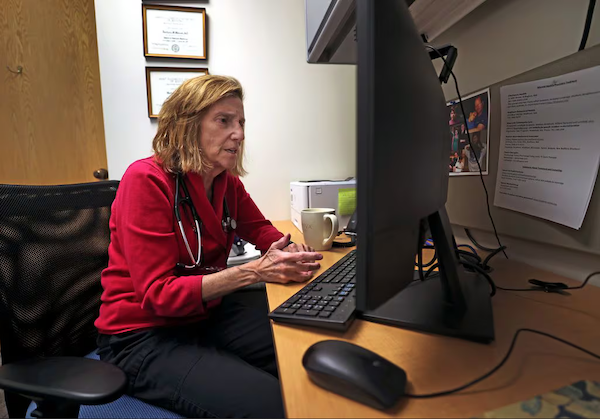About a third of Mass. voters are unhappy with health care access, new poll shows

DATE: April 26, 2024
Dissatisfaction was highest among Hispanic residents.

Dr. Barbara Spivak, a primary care doctor in Watertown and the president of the Massachusetts Medical Society, said primary care doctors make 20 percent less today in real wages than they did two decades ago.David L. Ryan/Globe Staff
by Adam Piore, Boston Globe Staff, April 26, 2024
About a third of Massachusetts residents are dissatisfied with their ability to access primary care doctors and specialists, according to a new poll.
Public health experts say those numbers, revealed in a new Suffolk University/Boston Globe poll of 500 Massachusetts voters likely to participate in the 2024 presidential election, are just the latest to highlight a growing capacity crisis in the state. Among the primary causes: Falling federal, state, and private insurance reimbursement rates and structural changes in the health care industry that favor high-cost medical procedures over payments for preventive care.
In the Globe poll, 33 percent of those surveyed said they were somewhat (18 percent) or very (15 percent) dissatisfied with the availability of primary care physicians when making appointments. The number rose to 37 percent when respondents were polled on the availability of specialists. The two problems are closely linked: The lack of available primary care providers and low reimbursement rates have increased pressure on primary care doctors to keep patient visits no longer than 10 to 15 minutes. That means they have no choice but to refer patients to specialists whose practices are also overwhelmed, said Barbra Rabson, chief executive of Massachusetts Health Quality Partners, a nonprofit group working to improve health care.
The dissatisfaction with primary care was highest among Hispanic residents. About 32 percent of white patients, 35 percent of Black patients, and 41 percent of Hispanic residents said they were “somewhat” or “very”dissatisfied when asked about primary care access. For specialists, 39 percent of white patients, 28 percent of Black patients, and 38 percent of Hispanic patients said they were dissatisfied.
Rabson said those numbers are consistent with previous polling done by organizations that closely track access to primary care and reflect a long-term deterioration in access that is only likely to worsen in the years ahead.
Primary care practices, she said, are “not getting enough money, not getting enough new staff — not getting enough anything.”
“Primary care is the foundation of our health care system,” said Rabson. “If primary care is in trouble, we’re all in trouble.”
The amount of money available to reimburse primary care doctors has been declining for years because national reimbursement rates for physician specialties, set by the Centers for Medicare & Medicaid Services (CMS), have failed to keep pace with inflation, said Dr. Barbara Spivak, a primary care doctor in Watertown and the president of the Massachusetts Medical Society. Those reimbursement rates are often used as reference points by insurance companies. Spivak said the failure of the federal government to raiseMedicare reimbursement in tandem with inflation means primary care doctors are making 20 percent less than they were two decades ago in real wages. State reimbursement rates through MassHealth are also notoriously low.
In recent years, the number of independent practices in Massachusetts has plummeted, as hospitals and group practices have snapped them up. Many of these entities have, in turn, been acquired by private equity firms. With these changes in ownership have come new pressures to minimize the attention given to individual patients and to refer them for costlier specialty services available at affiliated institutions.
It all adds up to a greater burden for many of those who remain in the profession.
“We went into primary care to truly serve patients and our communities and the profound disinvestment in primary care, the exodus of primary care clinicians, and the scope of illness that we are being asked to treat every day is demoralizing, exhaustin, and heartbreaking,” said Dr. Katherine Gergen Barnett, vice chair of primary care innovation and transformation at Boston Medical Center. “Improving primary care access and truly improving health equity in our communities can only be done by prioritizing our community health centers, shifting public budgets towards training more primary care providers, and doubling investment in primary care.”
The new business realities disincentivize medical students from choosing to specialize in primary care at a time when many practitioners in the field are retiring, experts said.
“When people are coming out of four years of college and four years of medical school with hundreds of thousands of dollars of loans, it’s very hard to choose a specialty where you’re going to make a lot less, a significant amount less,” said Spivak.
Spivak estimates thatprimary care doctors make between $100,000 and $400,000 less a yearthan medical students who choose other specialties.
Those numbers have a direct impact on the quality of care, said Rabson, whose group has partnered with the Center for Health Information and Analysis (CHIA), an independent state agency, to create a “dashboard” that displays health metrics and how they change over time. In 2021, the latest data available, more than one-third of residents surveyed reported that they had difficulty obtaining necessary health care in the past 12 months, an increase from 2019. Cancer and other preventive screening rates declined from 2018 to 2020.
In 2020, about 3.6 percent of primary care physicians in Massachusetts left the profession, compared with 3.3 percent for the United States overall. Almost 34 percent of those remaining were age 60 or older. With fewer and fewer newly minted medical school graduates willing to step in to replace them, the situation is approaching a crisis point and is bleeding into other areas of medicine, she said.
“The marketplace has changed; it’s about follow the money all the time,” she said. “And there’s nobody there to protect primary care and to say, ‘We need to provide prevention. We need to provide management of chronic diseases. We need to really help patients navigate the system.’ People aren’t interested in that, because it’s not where the money is. Our system is skewed towards intervention once people are sick, as opposed to focusing on wellness and keeping people better.”
Rabson’s group has also documented substantial racial and ethnic disparities in access to and utilization of primary care. In 2021, only 64 percent of Hispanic residents reported that they had a preventive care visit over the previous 12 months. For white residents, the number was 81 percent.
